André Rieu At Schönbrunn, Vienna (Trailer),the musical spectacle that
took place in the courtyard in front of Vienna's Schönbrunn Palace on 7 and 8 July 2006.
André Rieu
Early life
The name Rieu is of French Huguenot origin. Rieu's father, of the same name, was conductor of the Maastricht Symphony Orchestra. Showing early promise, André began studying violin at the age of five, from a very early age, he developed a fascination with orchestra. He studied violin at the Conservatoire Royal in Liège and at the Conservatorium Maastricht, (1968–1973), studying under Jo Juda and Herman Krebbers, from 1974 to 1977, he attended the Music Academy in Brussels, studying with André Gertler, finally receiving his degree "Premier Prix" from the Royal Conservatory of Brussels.
The name Rieu is of French Huguenot origin. Rieu's father, of the same name, was conductor of the Maastricht Symphony Orchestra. Showing early promise, André began studying violin at the age of five, from a very early age, he developed a fascination with orchestra. He studied violin at the Conservatoire Royal in Liège and at the Conservatorium Maastricht, (1968–1973), studying under Jo Juda and Herman Krebbers, from 1974 to 1977, he attended the Music Academy in Brussels, studying with André Gertler, finally receiving his degree "Premier Prix" from the Royal Conservatory of Brussels.
Career
At university he performed the Gold And Silver Waltz by Franz Lehár. Encouraged by the audience reaction, he decided to pursue the waltz form. Rieu created the Maastricht Salon Orchestra in 1978, and served as violinist with the Limburg Symphony Orchestra; in 1987, he created the Johann Strauss Orchestra and established his own production company. Since then, his melodramatic stage performances and rock-star demeanor have been widely associated with a revival of the waltz music category. André Rieu plays a 1667 Stradivarius violin.
At university he performed the Gold And Silver Waltz by Franz Lehár. Encouraged by the audience reaction, he decided to pursue the waltz form. Rieu created the Maastricht Salon Orchestra in 1978, and served as violinist with the Limburg Symphony Orchestra; in 1987, he created the Johann Strauss Orchestra and established his own production company. Since then, his melodramatic stage performances and rock-star demeanor have been widely associated with a revival of the waltz music category. André Rieu plays a 1667 Stradivarius violin.
Johann Strauss Orchestra
Rieu created Johann Strauss Orchestra in 1987 and began with 12 members, giving its first concert on 1 January 1988, over the years it has expanded dramatically, nowadays performing with between 80 and 150 musicians.
Rieu and his orchestra have performed throughout Europe, North and South America, Japan, and Australia, the size and revenue of their tours are rivalled only by the largest pop and rock music acts. In 2008 Rieu’s extravagant tour featured a full size reproduction of Empress Sisi’s Castle, the biggest stage ever to go on tour at that time, during the first half of 2009, André Rieu was the world’s most successful male touring artist, according to Billboard magazine.
- Recent world tour results in Billboard / Pollstar annual worldwide top tours lists
Year Rank # Shows Revenue Source 2016 #23 71 shows $40,169,471 Billboard Top 25 Tours 2016 2015 #20 101 shows $51,151,367 Billboard Top 25 Tours 2015 2014 #17 70 shows $42,983,266 Billboard Top 25 Tours 2014 2013 #20 70 shows $49,881,605 Billboard Top 25 Tours 2013 2012 #10 99 shows $46,785,71 Billboard Top 25 Tours 2012 2011 # 9 102 shows $67,104,756 Billboard Top 25 Tours 2011 2010 #16 86 shows $39,992,285 Billboard Top 25 Tours 2010 2009 # 6 112 shows $95,854,338 Billboard Top 25 Tours 2009 2008 # 8 71 shows $76.9 mll Pollstar’s top 10 worldwide tour acts 2008
Rieu records both DVD and CD repertoire at his own studios in Maastricht in a wide range of classical, popular, and folk music, as well as thematic music from well-known soundtracks and musical theatre, his lively orchestral presentations, in tandem with effective marketing, have attracted worldwide audiences to this emergent subgenre of classical music.
In addition to two World Music Awards, Rieu's recordings have gone gold and platinum in many countries, including 8-times Platinum in the Netherlands.
Television is also an important outlet for Rieu and his orchestra, their annual New Year's concerts from Vienna have become a Holiday tradition on public broadcasting stations. For two weeks in 2013, one of the channels of the BSkyB group, Sky Arts 2 in the UK, was renamed as Sky Arts Rieu. Between 30 March and 14 April 2013 Sky Arts Rieu broadcast Rieu concerts and documentaries 24 hours per day.
Rieu created Johann Strauss Orchestra in 1987 and began with 12 members, giving its first concert on 1 January 1988, over the years it has expanded dramatically, nowadays performing with between 80 and 150 musicians.
Rieu and his orchestra have performed throughout Europe, North and South America, Japan, and Australia, the size and revenue of their tours are rivalled only by the largest pop and rock music acts. In 2008 Rieu’s extravagant tour featured a full size reproduction of Empress Sisi’s Castle, the biggest stage ever to go on tour at that time, during the first half of 2009, André Rieu was the world’s most successful male touring artist, according to Billboard magazine.
- Recent world tour results in Billboard / Pollstar annual worldwide top tours lists
| Year | Rank | # Shows | Revenue | Source |
|---|---|---|---|---|
| 2016 | #23 | 71 shows | $40,169,471 | Billboard Top 25 Tours 2016 |
| 2015 | #20 | 101 shows | $51,151,367 | Billboard Top 25 Tours 2015 |
| 2014 | #17 | 70 shows | $42,983,266 | Billboard Top 25 Tours 2014 |
| 2013 | #20 | 70 shows | $49,881,605 | Billboard Top 25 Tours 2013 |
| 2012 | #10 | 99 shows | $46,785,71 | Billboard Top 25 Tours 2012 |
| 2011 | # 9 | 102 shows | $67,104,756 | Billboard Top 25 Tours 2011 |
| 2010 | #16 | 86 shows | $39,992,285 | Billboard Top 25 Tours 2010 |
| 2009 | # 6 | 112 shows | $95,854,338 | Billboard Top 25 Tours 2009 |
| 2008 | # 8 | 71 shows | $76.9 mll | Pollstar’s top 10 worldwide tour acts 2008 |
Rieu records both DVD and CD repertoire at his own studios in Maastricht in a wide range of classical, popular, and folk music, as well as thematic music from well-known soundtracks and musical theatre, his lively orchestral presentations, in tandem with effective marketing, have attracted worldwide audiences to this emergent subgenre of classical music.
In addition to two World Music Awards, Rieu's recordings have gone gold and platinum in many countries, including 8-times Platinum in the Netherlands.
Television is also an important outlet for Rieu and his orchestra, their annual New Year's concerts from Vienna have become a Holiday tradition on public broadcasting stations. For two weeks in 2013, one of the channels of the BSkyB group, Sky Arts 2 in the UK, was renamed as Sky Arts Rieu. Between 30 March and 14 April 2013 Sky Arts Rieu broadcast Rieu concerts and documentaries 24 hours per day.
Criticism
In spite of its wide international success, Rieu's mix of waltzes, popular music, comedy, and pathos has attracted its critics. Chris Boyd, a critic writing for Melbourne's Herald Sun newspaper, did not criticize his playing, but described his main stage function as "blarney and delegation".
Of Rieu's popularity and the media debate surrounding him, Eamon Kelly wrote in The Australian newspaper: "It is disappointing to see professional journalists indulging in cheap, inaccurate stereotypes to dismiss criticism of Rieu." But he goes on to add: "Equally misguided are those who cursorily dismiss Rieu. Rieu's live and recorded performances have brought joy to millions of people. Few in his audiences are regular classical music attendees and it could be seen as promising that, via Rieu, they are listening to standards of the classical canon, the fact that Rieu's focus is on highly accessible, enjoyable repertoire is not an argument against his musical credentials."
In spite of its wide international success, Rieu's mix of waltzes, popular music, comedy, and pathos has attracted its critics. Chris Boyd, a critic writing for Melbourne's Herald Sun newspaper, did not criticize his playing, but described his main stage function as "blarney and delegation".
Of Rieu's popularity and the media debate surrounding him, Eamon Kelly wrote in The Australian newspaper: "It is disappointing to see professional journalists indulging in cheap, inaccurate stereotypes to dismiss criticism of Rieu." But he goes on to add: "Equally misguided are those who cursorily dismiss Rieu. Rieu's live and recorded performances have brought joy to millions of people. Few in his audiences are regular classical music attendees and it could be seen as promising that, via Rieu, they are listening to standards of the classical canon, the fact that Rieu's focus is on highly accessible, enjoyable repertoire is not an argument against his musical credentials."
Honours
- Knight of the Order of the Netherlands Lion (Netherlands, 2002)
- Honorary Medal of the Province of Limburg (Netherlands, 2009)
- Knight of the Order of Arts and Letters (France, 2009)
- Knight of the Order of the Netherlands Lion (Netherlands, 2002)
- Honorary Medal of the Province of Limburg (Netherlands, 2009)
- Knight of the Order of Arts and Letters (France, 2009)
Selected discography
- Maastricht Salon Orkest – Serenata (1984)
- Hieringe biete 1 (1989)
- D'n blauwen aovond (1992)
- Merry Christmas (1992)
- Strauss & Co (1994)
- The Vienna I Love (1995)
- In Concert (1996)
- Strauss Gala (1997)
- The Christmas I Love (October 1997)
- Romantic Moments (1998)
- 100 Years of Strauss (1999)
- Fiesta! (October 1999)
- La vie est belle (2000) – Berlin
- Musik zum Träumen (Dreaming) (2001)
- Live at the Royal Albert Hall (April 2002)
- Love Around the World (November 2002)
- Gala Concert (December 2002) – Hamburg
- Romantic Paradise (September 2003) – Cortona, Italy
- Live in Dublin (October 2003)
- André Rieu at the Movies (March 2004)
- The Flying Dutchman (July 2004)
- Live in Tuscany (September 2004)
- Songs from My Heart (2005)
- Roses from the South (June 2005) – Mainau, Germany
- New Year's Eve in Vienna (October 2005)
- Auf Schönbrunn (July 2006) – Vienna)
- Christmas Around the World (October 2006)
- New York Memories (November 2006) – Radio City NY
- The 100 Most Beautiful Melodies (May 2007) – Australian Albums: No.2
- Masterpieces (September 2007) – Australian Albums: No.9
- In Wonderland (November 2007) – Efteling, Nederland
- Waltzing Matilda (April 2008) – Australian Albums: No.1
- Live in Vienna (September 2008)
- Ich tanze mit dir in den Himmel hinein (October 2008) – Wedding, Semper Opera, Dresden
- Live in Maastricht II (November 2008)
- Live in Australia (December 2008) – Australian Albums: No.14
- You'll Never Walk Alone (May 2009) – Australian Albums: No.2
- Live in Maastricht III (8 September 2009)
- I Lost My Heart in Heidelberg (29 September 2009) – with the Berlin Comedian Harmonists
- The Very Best of André Rieu (October 2009) – Australian Albums: No.23
- Forever Vienna (December 2009) – UK: #2, IRE: No.4
- You Raise Me Up – Songs for Mum (May 2010) – Australian Albums: No.8
- My African Dream (August 2010) – South Africa
- Live in Maastricht IV (September 2010)
- Moonlight Serenade (November 2010) – Australian Albums: No.17
- And the Waltz Goes On (2011)
- Live in Brazil (2012)
- Home for Christmas (11 December 2012)
- Live in Maastricht VI (October 2013) – 25th anniversary
- Nuits magiques (November 2013)
- Music of the Night (2013)
- Love Letters (February 2014)
- Les mélodies du bonheur (May 2014)
- Un amour à Venise (November 2014)
- Magic of the Violin (May 2015) – with His Johann Strauss Orchestra
- Roman Holiday (November 2015) – with His Johann Strauss Orchestra
- Magic of the Waltz (May 2016) – with His Johann Strauss Orchestra
- Viva Olympia (August 2016) – with His Johann Strauss Orchestra
- Falling in Love (November 2016) – with His Johann Strauss Orchestra
- Amore (December 2017)
- Maastricht Salon Orkest – Serenata (1984)
- Hieringe biete 1 (1989)
- D'n blauwen aovond (1992)
- Merry Christmas (1992)
- Strauss & Co (1994)
- The Vienna I Love (1995)
- In Concert (1996)
- Strauss Gala (1997)
- The Christmas I Love (October 1997)
- Romantic Moments (1998)
- 100 Years of Strauss (1999)
- Fiesta! (October 1999)
- La vie est belle (2000) – Berlin
- Musik zum Träumen (Dreaming) (2001)
- Live at the Royal Albert Hall (April 2002)
- Love Around the World (November 2002)
- Gala Concert (December 2002) – Hamburg
- Romantic Paradise (September 2003) – Cortona, Italy
- Live in Dublin (October 2003)
- André Rieu at the Movies (March 2004)
- The Flying Dutchman (July 2004)
- Live in Tuscany (September 2004)
- Songs from My Heart (2005)
- Roses from the South (June 2005) – Mainau, Germany
- New Year's Eve in Vienna (October 2005)
- Auf Schönbrunn (July 2006) – Vienna)
- Christmas Around the World (October 2006)
- New York Memories (November 2006) – Radio City NY
- The 100 Most Beautiful Melodies (May 2007) – Australian Albums: No.2
- Masterpieces (September 2007) – Australian Albums: No.9
- In Wonderland (November 2007) – Efteling, Nederland
- Waltzing Matilda (April 2008) – Australian Albums: No.1
- Live in Vienna (September 2008)
- Ich tanze mit dir in den Himmel hinein (October 2008) – Wedding, Semper Opera, Dresden
- Live in Maastricht II (November 2008)
- Live in Australia (December 2008) – Australian Albums: No.14
- You'll Never Walk Alone (May 2009) – Australian Albums: No.2
- Live in Maastricht III (8 September 2009)
- I Lost My Heart in Heidelberg (29 September 2009) – with the Berlin Comedian Harmonists
- The Very Best of André Rieu (October 2009) – Australian Albums: No.23
- Forever Vienna (December 2009) – UK: #2, IRE: No.4
- You Raise Me Up – Songs for Mum (May 2010) – Australian Albums: No.8
- My African Dream (August 2010) – South Africa
- Live in Maastricht IV (September 2010)
- Moonlight Serenade (November 2010) – Australian Albums: No.17
- And the Waltz Goes On (2011)
- Live in Brazil (2012)
- Home for Christmas (11 December 2012)
- Live in Maastricht VI (October 2013) – 25th anniversary
- Nuits magiques (November 2013)
- Music of the Night (2013)
- Love Letters (February 2014)
- Les mélodies du bonheur (May 2014)
- Un amour à Venise (November 2014)
- Magic of the Violin (May 2015) – with His Johann Strauss Orchestra
- Roman Holiday (November 2015) – with His Johann Strauss Orchestra
- Magic of the Waltz (May 2016) – with His Johann Strauss Orchestra
- Viva Olympia (August 2016) – with His Johann Strauss Orchestra
- Falling in Love (November 2016) – with His Johann Strauss Orchestra
- Amore (December 2017)
-VIDEO :The Best Of André Rieu (HD)_playlist.
-VIDEO : FALLING IN LOVE_Playlist.
-VIDEO : Welcome To My World - André Rieu_playlist.
-VIDEO : André Rieu – Best of Love Songs_playlist.
-VIDEO : Roman Holiday_playlist.
-VIDEO :André Rieu - Romantic Paradise (live in Tuscany)_playlist
-VIDEO : André Rieu - Live in Vienna_playlist.

Viennese Waltz
Viennese Waltz - one of the ballroom dances of the European program. Looks like a slow waltz, has the same count - "One, two, three," but differs in the number of beats per minute, that is, the execution rate (58-60 beats per minute, the time signature 3 / 4).
Despite its name, the Viennese waltz was not born in Austria. There are two versions of the origin of dance - German (in England it long called the "German" waltz), and French-Italian.
In the 70's. XVIII century. peasant dance called the waltz of some areas of southern Germany and Austria (Lendler), gradually became popular throughout society. The maximum momentum he got in the works of Strauss's father, and later his sons, Joseph and Johann
Were also spread a variety of options for the French waltz, composed of three parts with different tempo of 3 / 4, 3 / 8, 6 / 8.
Waltz performed to music with three beats per measure. Each cycle begins and ends with a score of shock less isolated. One of the earliest known dance in the rhythm - the national dance of the French Provence (Provence) - appeared in 1559. Music that was performed a dance called "Volta", and also at the same time was called the Italian folk dance. Translated from the Italian "volta" means "turn".
In the 16th century Volta is becoming popular in Western Europe. In the Volta partner dancing in both the modern waltz, but the lady moved to the left relative to the gentleman and kept her skirt with his left hand.
More than anything, like Volta modern Norwegian folk version of the waltz. To partner could circumvent a partner in the movement, in the Norwegian Waltz partner picks it up off the floor and moves through the air. In the Volta partners did the same thing, holding on to each other. Volta, originally performed at the three accounts, but in fact in five steps.
In 1754, there was music in Germany under the name "Waltzen", which has some similarities with the modern. The first tune of the Viennese waltz dates back to 1770.
At that time, the waltz was considered immoral because of the tight junction, but that changed after the French Revolution. He was a great success in all walks of life and created a furor in numerous Parisian ballroom salons. With Napoleon's troops, it spread throughout Europe. At the same time waltz was very popular at the Russian court - it was a favorite dance of the wife of Emperor Paul I.
In England, the waltz came in the early 18th century under the name "German Waltz" and caused a strong sensation. Official recognition he received in 1826 and became a court dance.
After World War waltz several lost their positions emerged a new dance: jazz, Charleston, Foxtrot, Tango and others.
Today, it is not as popular, but still collect a considerable number of fans around the world.
Currently, the Viennese waltz performed to the rhythm of 180 beats per minute, with a limited set of motions: change steps, passing changes, natural and reverse turns, moving to the center of rotation and (Fleckerls), passing in contracheck, Pivots.
The Viennese waltz is an indispensable part of dance championships as a dance in which dancers can show contestants graceful fluidity of their movements, endurance and ability to control the speed of movement around the room.

Despite its name, the Viennese waltz was not born in Austria. There are two versions of the origin of dance - German (in England it long called the "German" waltz), and French-Italian.
In the 70's. XVIII century. peasant dance called the waltz of some areas of southern Germany and Austria (Lendler), gradually became popular throughout society. The maximum momentum he got in the works of Strauss's father, and later his sons, Joseph and Johann
Were also spread a variety of options for the French waltz, composed of three parts with different tempo of 3 / 4, 3 / 8, 6 / 8.
Waltz performed to music with three beats per measure. Each cycle begins and ends with a score of shock less isolated. One of the earliest known dance in the rhythm - the national dance of the French Provence (Provence) - appeared in 1559. Music that was performed a dance called "Volta", and also at the same time was called the Italian folk dance. Translated from the Italian "volta" means "turn".
In the 16th century Volta is becoming popular in Western Europe. In the Volta partner dancing in both the modern waltz, but the lady moved to the left relative to the gentleman and kept her skirt with his left hand.
More than anything, like Volta modern Norwegian folk version of the waltz. To partner could circumvent a partner in the movement, in the Norwegian Waltz partner picks it up off the floor and moves through the air. In the Volta partners did the same thing, holding on to each other. Volta, originally performed at the three accounts, but in fact in five steps.
In 1754, there was music in Germany under the name "Waltzen", which has some similarities with the modern. The first tune of the Viennese waltz dates back to 1770.
At that time, the waltz was considered immoral because of the tight junction, but that changed after the French Revolution. He was a great success in all walks of life and created a furor in numerous Parisian ballroom salons. With Napoleon's troops, it spread throughout Europe. At the same time waltz was very popular at the Russian court - it was a favorite dance of the wife of Emperor Paul I.
In England, the waltz came in the early 18th century under the name "German Waltz" and caused a strong sensation. Official recognition he received in 1826 and became a court dance.
After World War waltz several lost their positions emerged a new dance: jazz, Charleston, Foxtrot, Tango and others.
Today, it is not as popular, but still collect a considerable number of fans around the world.
Currently, the Viennese waltz performed to the rhythm of 180 beats per minute, with a limited set of motions: change steps, passing changes, natural and reverse turns, moving to the center of rotation and (Fleckerls), passing in contracheck, Pivots.
The Viennese waltz is an indispensable part of dance championships as a dance in which dancers can show contestants graceful fluidity of their movements, endurance and ability to control the speed of movement around the room.
Temporary Rieu themed TV channel
One of the channels of the BSkyB group, Sky Arts 2 in the UK, was renamed as Sky Arts Rieu in his honour. Between 30 March and 14 April, 2013 Sky Arts Rieu broadcast Rieu concerts and documentaries 24 hours per day.
-VIDEO :André Rieu - Parade Of The Charioteers (Ben Hur)André Rieu, over 500 brass players & the JSO performing 'Parade Of The Charioteers' from the movie Ben Hur live in Amsterdam.
André Rieu - Bésame Mucho :
-VIDEO :André Rieu - Live in Vienna
-VIDEO :Andre Rieu-The 100 Greatest Moments
-VIDEO :Vienna Philharmonic New Year's Concert 2014 Full (HD)
-VIDEO :André Rieu - And The Waltz Goes On
-VIDEO :Andre Rieu-Full Concerts_65 videos.
-VIDEO :André Rieu – The 50 Greatest Love Themes
-VIDEO : André Rieu Full Concerts
-VIDEO : The Best Of Andre Rieu [HD Videos]_32 videos.
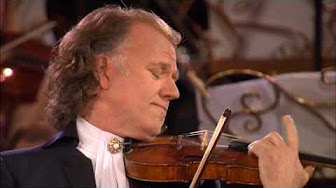
37

The Best Of André Rieu (HD)

Vienna City Hall, Rathaus
Vienna ( German: Wien, pronounced [viːn] ( listen)) is the capital and largest city of Austria and one of the nine states of Austria. Vienna is Austria's primary city, with a population of about 1.8 million (2.6 million within the metropolitan area, nearly one third of Austria's population), and its cultural, economic, and political centre. It is the 7th-largest city by population within city limits in the European Union, until the beginning of the 20th century, it was the largest German-speaking city in the world, and before the splitting of the Austro-Hungarian Empirein World War I, the city had 2 million inhabitants. Today, it has the second largest number of German speakers after Berlin. Vienna is host to many major international organizations, including the United Nations and OPEC, the city is located in the eastern part of Austria and is close to the borders of the Czech Republic, Slovakia, and Hungary. These regions work together in a European Centrope border region. Along with nearby Bratislava, Vienna forms a metropolitan region with 3 million inhabitants. In 2001, the city centre was designated a UNESCO World Heritage Site; in July 2017 it was moved to the list of World Heritage in Danger.
listen)) is the capital and largest city of Austria and one of the nine states of Austria. Vienna is Austria's primary city, with a population of about 1.8 million (2.6 million within the metropolitan area, nearly one third of Austria's population), and its cultural, economic, and political centre. It is the 7th-largest city by population within city limits in the European Union, until the beginning of the 20th century, it was the largest German-speaking city in the world, and before the splitting of the Austro-Hungarian Empirein World War I, the city had 2 million inhabitants. Today, it has the second largest number of German speakers after Berlin. Vienna is host to many major international organizations, including the United Nations and OPEC, the city is located in the eastern part of Austria and is close to the borders of the Czech Republic, Slovakia, and Hungary. These regions work together in a European Centrope border region. Along with nearby Bratislava, Vienna forms a metropolitan region with 3 million inhabitants. In 2001, the city centre was designated a UNESCO World Heritage Site; in July 2017 it was moved to the list of World Heritage in Danger.
Apart from being regarded as the City of Music because of its musical legacy, Vienna is also said to be "The City of Dreams" because it was home to the world's first psycho-analyst – Sigmund Freud, the city's roots lie in early Celtic and Roman settlements that transformed into a Medieva land Baroque city, and then the capital of the Austro-Hungarian Empire. It is well known for having played an essential role as a leading European music centre, from the great age of Viennese Classicism through the early part of the 20th century, the historic centre of Vienna is rich in architectural ensembles, including Baroque castles and gardens, and the late-19th-century Ringstraße lined with grand buildings, monuments and parks.
Vienna is known for its high quality of life; in a 2005 study of 127 world cities, the Economist Intelligence Unit ranked the city first (in a tie with Vancouver, Canada and San Francisco, USA) for the world's most liveable cities. Between 2011 and 2015, Vienna was ranked second, behind Melbourne, Australia. For eight consecutive years (2009–2016), the human-resource-consulting firm Mercer ranked Vienna first in its annual "Quality of Living" survey of hundreds of cities around the world, a title the city still held in 2016.Monocle's 2015 "Quality of Life Survey" ranked Vienna second on a list of the top 25 cities in the world "to make a base within."
The UN-Habitat has classified Vienna as being the most prosperous city in the world in 2012/2013, the city was ranked 1st globally for its culture of innovation in 2007 and 2008, and sixth globally (out of 256 cities) in the 2014 Innovation Cities Index, which analyzed 162 indicators in covering three areas: culture, infrastructure, and markets. Vienna regularly hosts urban planning conferences and is often used as a case study by urban planners.
Between 2005 and 2010, Vienna was the world's number-one destination for international congresses and conventions, it attracts over 6.8 million tourists a year.
-VIDEO :Popular Videos - André Rieu_200 videos

Schönbrunn Palace in Vienna, Austria (Schönbrunn Palace, view from Gloriette.)
Schönbrunn Palace (German: Schloss Schönbrunn [ʃøːnˈbʁʊn]) is a former imperial summer residence located in Vienna, Austria. The 1,441-room Baroque palace is one of the most important architectural, cultural and historical monuments in the country. Since the mid-1950s it has been a major tourist attraction. The history of the palace and its vast gardens spans over 300 years, reflecting the changing tastes, interests, and aspirations of successive Habsburg monarchs.


Schönbrunn palace from main entrance.
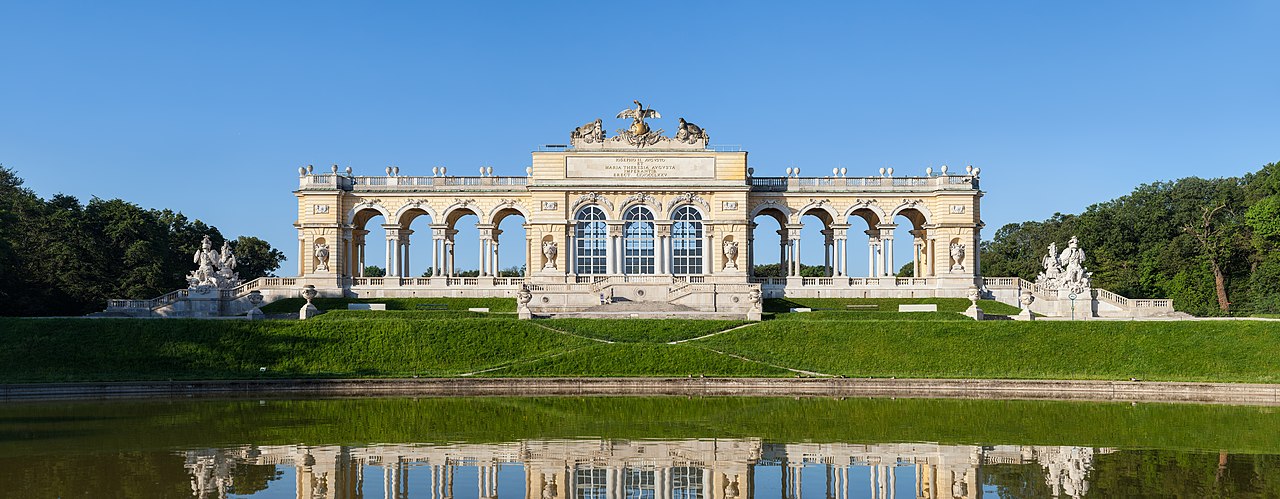
The Gloriette in the Schönbrunn Palace Garden

Gardens, Gloriette and Neptune Fountain of Schönbrunn Palace

Gloriette, the Neptune Fountain, and the Great Parterre

Gloriette, the Neptune Fountain, and the Great Parterre
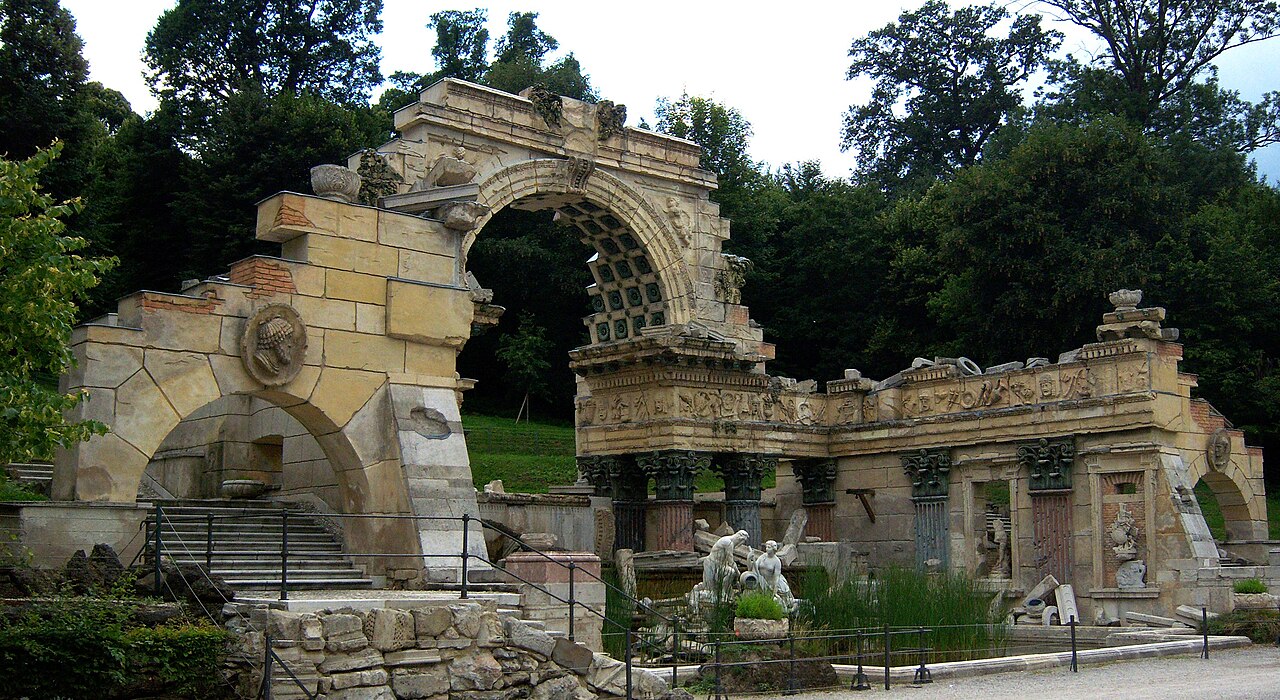
Roman Ruins at Schönbrunn

Panorama of Schönbrunn with Vienna in the Background.


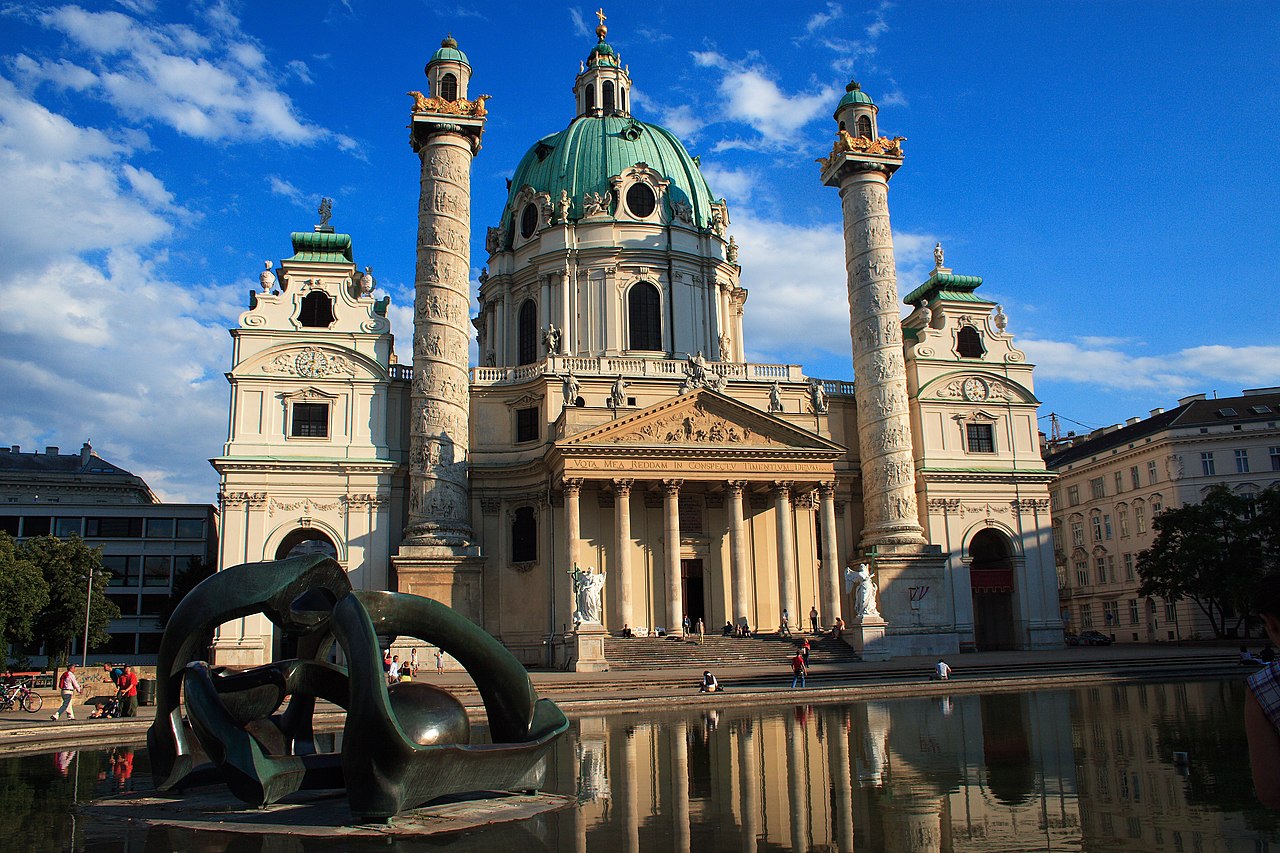


Schönbrunn Gardens in autumn
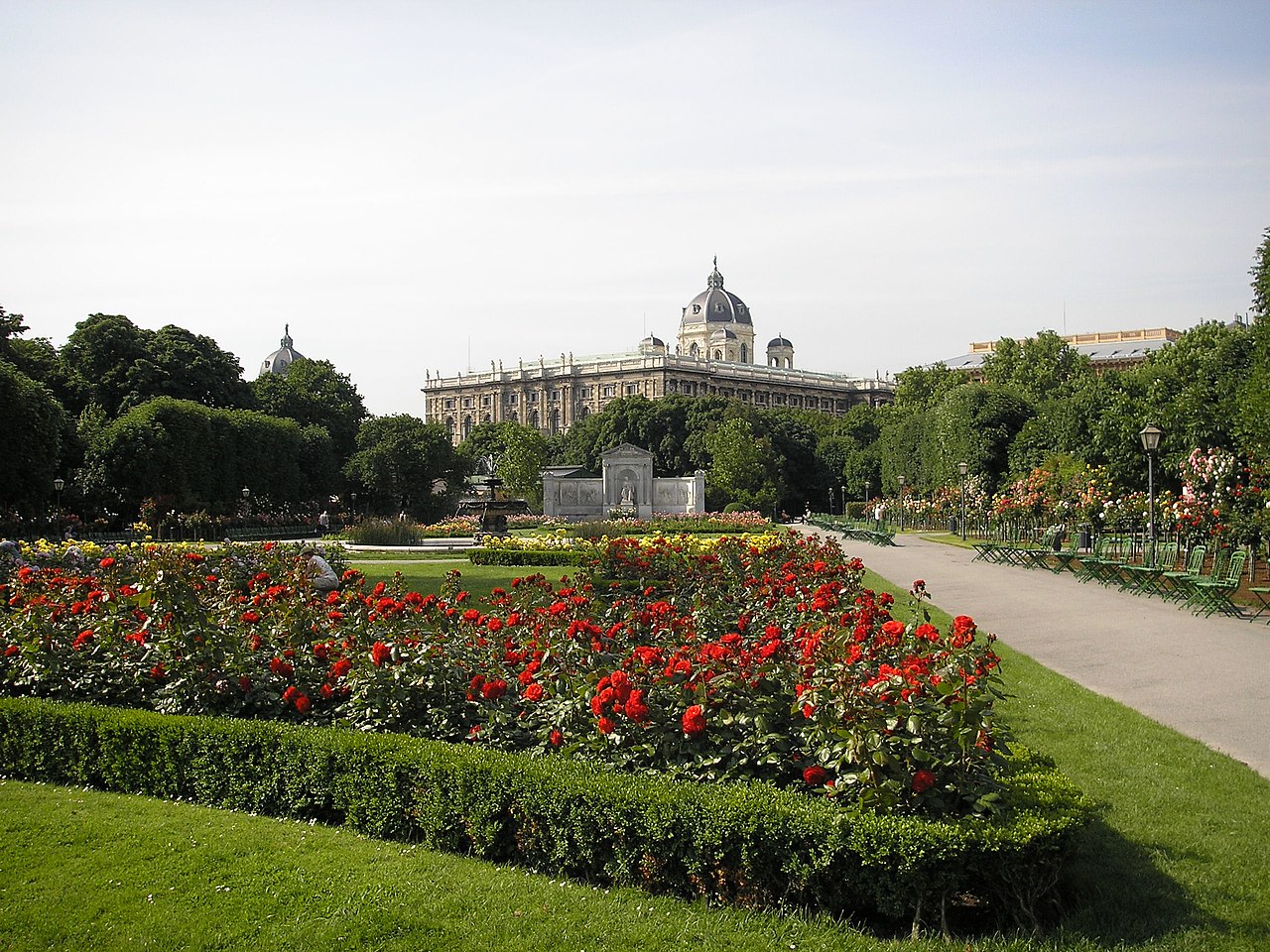
Vienna city park


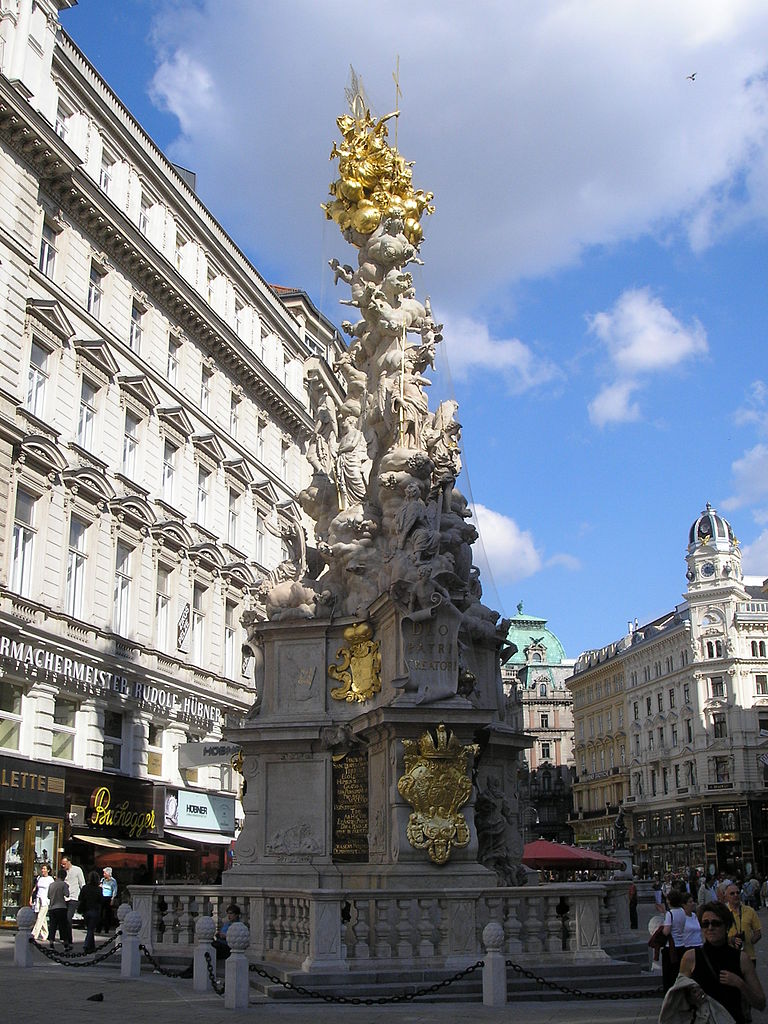




Vienna State Opera

view from Wiener Riesenrad


view from Wiener Riesenrad

Middle Common Coat of Arms of Austria-Hungary, designed in 1915 Background transparency

Cover
The Blue Danube is the common English title of An der schönen blauen Donau, Op. 314 (German for "By the Beautiful Blue Danube"), a waltz by the Austrian composer Johann Strauss II, composed in 1866. Originally performed in February, 1867 at a concert of the Wiener Männergesangsverein (Vienna Men's Choral Association), it has been one of the most consistently popular pieces of music in the classical repertoire. Its initial performance was considered only a mild success, however, and Strauss is reputed to have said, "The devil take the waltz, my only regret is for the coda—I wish that had been a success!"
After the original music was written, the words were added by the Choral Association's poet, Joseph Weyl. Strauss later added more music, and Weyl needed to change some of the words. Strauss adapted it into a purely orchestral version for the 1867 Paris World's Fair, and it became a great success in this form. The instrumental version is by far the most commonly performed today. An alternate text was written by Franz von Gernerth, "Donau so blau" (Danube so blue). "The Blue Danube" premiered in the United States in its instrumental version on 1 July 1867 in New York, and in Great Britain in its choral version on 21 September 1867 in London at the promenade concerts at Covent Garden.
When Strauss's stepdaughter, Alice von Meyszner-Strauss, asked the composer Johannes Brahms to sign her autograph-fan, he wrote down the first bars of The Blue Danube, but adding "Leider nicht von Johannes Brahms" ("Alas! not by Johannes Brahms")

Map indicating the Danube
-VIDEO :André Rieu - The Beautiful Blue Danube
André Rieu & his Johann Strauss Orchestra playing "The Beautiful Blue Danube" (An der schönen blauen Donau) by composer Johann Strauss II. Recorded live at Empress Sisi's castle; Schönbrunn Palace Vienna, Austria with dancers from the famous Austrian Elmayer Dancing School.
Panorama of the Danube in Vienna
The Danube is Europe's second-longest river, after the Volga River, and also the longest river in the European Union region. It is located in Central and Eastern Europe.
The Danube was once a long-standing frontier of the Roman Empire, and today flows through 10 countries. Originating in Germany, the Danube flows southeast for 2,860 km (1,780 mi), passing through or touching the border of Austria, Slovakia, Hungary, Croatia, Serbia, Romania, Bulgaria, Moldova and Ukraine before emptying into the Black Sea. Its drainage basin extends into nine more countries.

The Danube Bend is a curve of the Danube in Hungary, near the city of Visegrád. The Transdanubian Mountains lie on the right bank (left side of the picture), while the North Hungarian Mountains on the left bank (right side of the picture).

Panorama of the Danube in Budapest

Budapest at night

The Danube in Budapest

Pelicans in the Danube Delta, Romania


The Viennese Waltz by Vladimir Pervuninsky, Russian, born in 1957

Vladimir Pervunensky. A Ball to the Sounds of Strauss. 2005
A glittering waltz in Vienna, Austria in late 1800s. Strauss waltzes were enormously popular at such events.

Art, 19Th Century, Palaces, Painting, Concert Hall
200 Years of Viennese Waltz 13/05/2014
The product of a more elegant age, the Viennese Waltz was introduced in Vienna in the early 1800s



vladimir pervuninsky paintings
.gif)


No comments:
Post a Comment